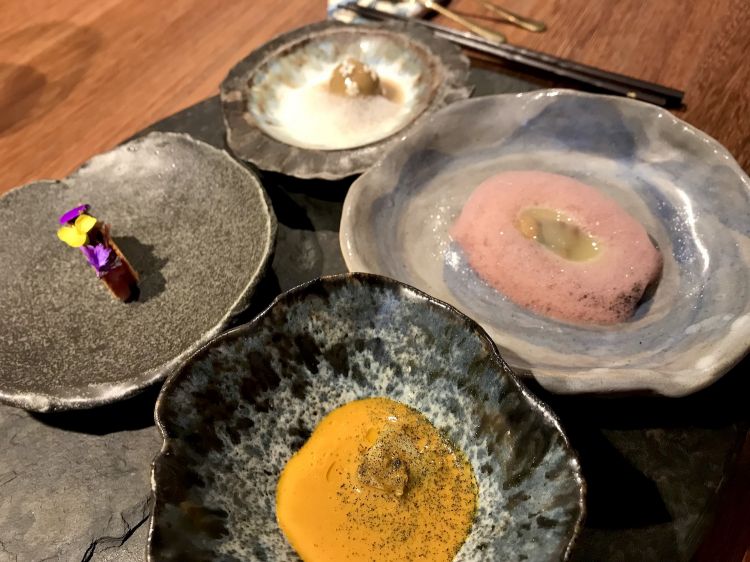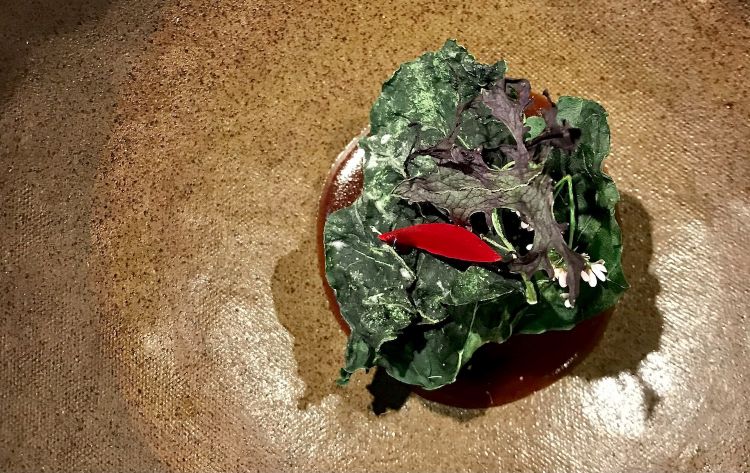Some time ago, the great Spanish gastronomist (now based in Latin America) Ignacio Medina wrote, almost suffering, of a dish he really couldn't get out of his mind, "I'm still thinking about it, three weeks after eating it. It has all I look for: surprise, clarity, simplicity, textures and emotions. I also feel it's an unquestionable reference to understand the journey followed by the most advanced cook in the Latin American scene, and a point of reference for Colombian restaurants". Something very similar happened to us, though not exactly the same, after tasting Tongue and skin of pirarucù from Leo Espinosa, at restaurant Leo in Bogotá, number 46 in the World's 50Best, 14 in the 50Best Latin America.

Tongue and skin of pirarucù
A small digression.
Pirarucù is the large freshwater fish in the photo below. A super-fish (
Arapaima gigas, that is to say giant arapaima), which can mostly be found in the basin of the Amazon River, and which reaches 2 metres of length, on average, and weighs 200-440 kg as an adult.
We enjoyed the above mentioned
Tongue and skin of pirarucù, rich in collagen; but perhaps we enjoyed even more the previous dish,
Pirarucù, sour manioca, cacay milk and katara, perfect in its balance of flavours (cacay -
Caryodendron orinocense – is one of the most promising species of the Amazon biodiversity, its nuts are rich in proteins, minerals and fibres, and you can also extract an oil from them. With its flour, instead, you can make milk, as in this case.
Katara is a spicy sauce similar to soya sauce, made by processing an extract of yucca).

Pirarucù, sour manioca, cacay milk and katara
We've dwelled on this introduction to give you an idea of how the chef works.
Leonor Espinosa De La Ossa – this her full name – is no longer super-young, being born in 1963, but is conducting an extraordinary work of avantgarde, not only culinary but also cultural, social, anthropological. Her culinary offer reclaims the ancient local flavours; she conducts her fieldwork, investigates the most remote corners of Colombia, the 26th largest country in the world, and the 4th in Latin America, with a very rich biodiversity: two oceans, the Andes to the west, dividing into three mountain chains separated by green valleys, a plane to the east, big rivers, volcanoes, a mosaic of climates and microclimates, from savannahs to the super-humid jungles, to the arid deserts of Tatacoa and Candelaria, to the extreme cold glaciers of the Andes. In 2008
Leo also created
Foundation Leo Espinosa (
Funleo) which has the goal of promoting initiatives for the development of rural communities, reinforcing their culinary traditions, diet and nutritional safety. «We aim for a cuisine in which the use of raw materials is full, we can talk of
cocina circular», she tells us.
Today her most important project is called
CiclioBioma. We already wrote about it
briefly here, when presenting
Espinosa's lesson at
Bogotá Madrid Fusión:
The chef, with her daughter Laura Hernández who is the sommelier, presented a lesson titled “Territorio - CicloBioma: experiential interpretation of Colombian ecosystems” strongly focused on the new pairing presented at their restaurant, a pairing with an innovative concept, a sort of “Amazonian mixology” developed in a project called Territorio. It's based on some cocktails developed by Hernández in partnership with the Universidad de los Andes, each inspired by the flavours of the ecosystem, and made with herbs and fruits. They are called Páramo (bay leaf and rosemary), Desierto (prickly pear and nopal), Bosque de Niebla (honey from the forests of Sotaquirá in the Andes, Boyacá), Piedemonte (cocoa leaves and Arauca cocoa beans), Montaña (distilled gulupa).
The same cocktails partly accompanied our meal. In general, CiclioBioma means the study of the Colombian territory in its different ecosystems through research, development and innovation. In each biome, she and her staff work with biologists, farmers and producers to make place for local products that recreate the collective memory of Colombia.
Take the appetizers, eight small dishes:

From the right, clockwise, Mussels, green coconut, foam of organic salt from Galerazamba; Dried prawns, Copey sea snails, coconut and azotea herbs; Alalunga tuna, hormiga culona, mañoco, cane honey and seaweeds; King crab

From the right, clockwise: Cucha, oil of mojojoy, creole saffron; Heart of palm, mojojoy, huito; Salted marshmallow of tail of Amazon caiman with palmito; Broth of ray fish, hormiga limonera and citrus herbs
In the first photo, we have
Mussels, green coconut, foam of organic salt from Galerazamba (the pink foam);
Dried prawns, Copey sea snails, coconut and azotea herbs, a mix of wild herbs that grow among the orchids on the Pacific coast (oregano, coriander, basil...);
Alalunga tuna, hormiga culona, mañoco, cane honey and seaweeds (
hormiga culona, which means with a big bottom, is the
Atta laevigata;
mañoco is a manioca cracker);
King crab, transformed into a dim sum with its foam. In the second photo:
Cucha, oil of mojojoy, creole saffron (
cucha is a catfish of the "open mouth" variety,
mojojoy is made with dehydrated and powdered cockroach larvae);
Heart of palm, mojojoy, huito (that is to say the
Genipa americana tree);
Salted marshmallow of tail of Amazon caiman with palmito; finally
Broth of ray fish, hormiga limonera and citrus herbs (the ray fish is smoked, then there's the aji negro and a spicy note given by the limonere ants -
Myrmelachista schumanni – cooked with fermented manioca juice, a traditional Amazon recipe).
Then there are 1+4 meat-based dishes (in all honesty, far too many, even in a long tasting menu as the one we were expecting).

Broth of guinea fowl, tallo leaf, green corn and casabe
.
Tallo is an Amazon cabbage, the texture of the broth is given by the
casabe, the starch in manioca flour. An exceptional dish, extremely elegant.

Denver cut beef, fern in brine, native potatoes, siete cuero and paipa
. The meat is first smoked with the fern leaves and then fried with an oil from the same plant. Then there's a purée of native potatoes and
siete cuero and
paipa, two Colombian cheese. The meat is exceptional, the seasoning even too rich.

Goat, tamaca, wild oregano of the desert
.
Tamaca is the fruit of a variety of palm called "palm of America". The dish (a very fine one) is inspired by the traditional
chicarro, a stew made with sweet peppers, cumin, oregano and tamaca milk, made with the seeds of tamaca eaten and digested by the cattle.

Savannah pig, red rice from Guajira
. This is also inspired by a traditional dish,
frijoles con garra, pig feet with beans. In this case the chef uses jowl bacon and uses the rest to make a small stew.

Cured neck of ram, ancient Arhuacos cocoa and ocañera onion
. They make a demi-glace aromatised with cocoa, then dehydrated vegetables: cabbage leaves, lettuce and this special
ocañera onion.
As you can tell, a great and very interesting dinner. The desserts, however, are the most extraordinary part of the entire menu, from a culinary point of view.

Macambo, anise, loquats, Tumaco cocoa
. There's a
macambo ice cream (
Theobroma bicolor), a fruit of the cocoa family native of the Amazon region, a praline of caramel, cashew nuts and
sacha inchi (
Plukenetia volubilis), also known as Inca peanuts, loquats and cocoa.

Gelatine of potato, coquindo, salt of Manure
. Excellent. Coquindo is a plant (
Aspidosperma album) of the
Apocynaceae family.

Pulantana, granita of Tayrona cocoa
. An absolutely exceptional dessert, playing between the notes of coffee and cocoa. It's made with a drink called
caffè guajiro made with
pulantana, the seed of a plant from the Colombian desert. It has no caffeine. The dessert is served with a lemon granita and sweet cocoa.
Finally,
Coffee and cocoa. Three types of coffee with as many cocoa truffles, to discover a world of taste nuances: honey, caramel, grass, citrus fruits, chocolate, with flowery, sweet and bitter notes. Extraordinary.
Translated into English by Slawka G. Scarso